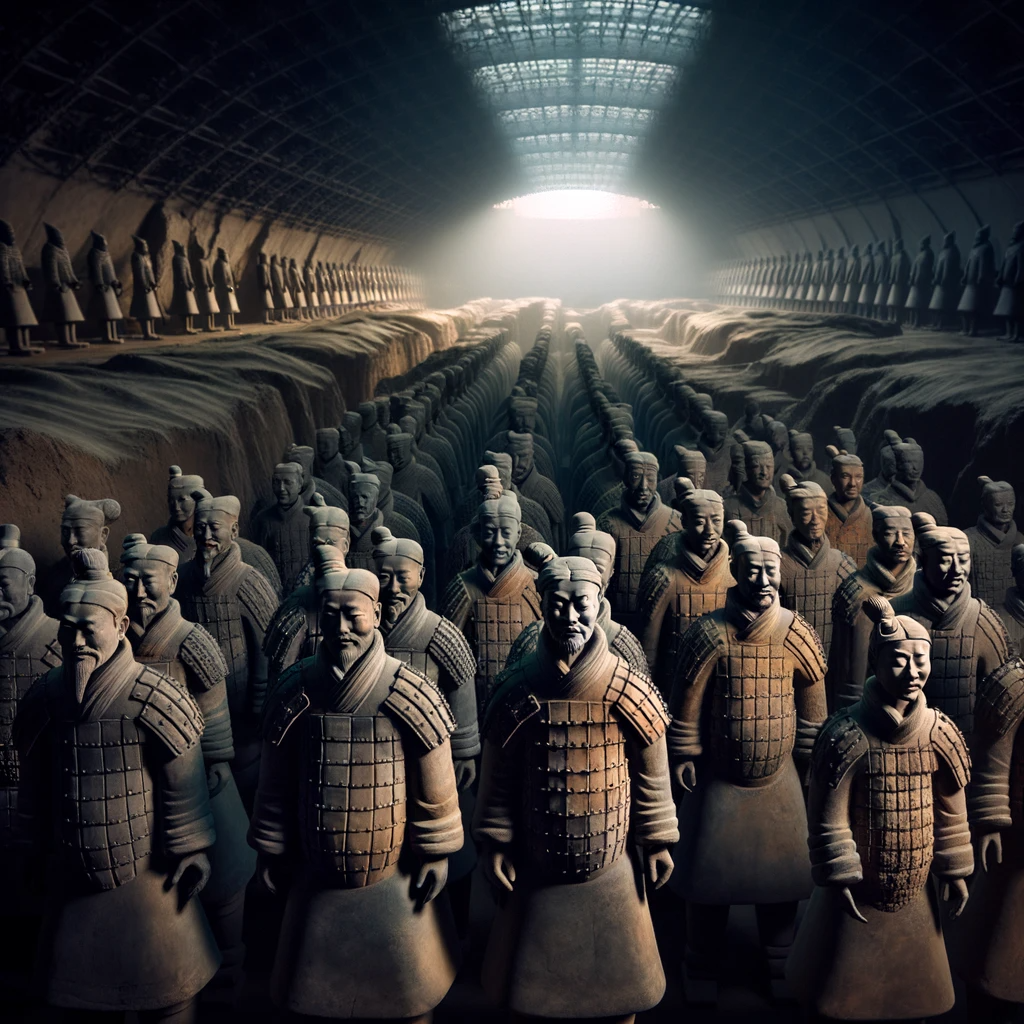The Terracotta Army is one of the most astonishing archaeological discoveries of the 20th century. This incredible life-sized army of thousands was created to guard China’s first emperor in the afterlife. The army remained hidden underground for over 2,000 years before being uncovered in 1974.
The Terracotta Army provides a captivating glimpse into the power and ambition of China’s first emperor, Qin Shi Huang. The sheer scale and detail of the warriors are astounding. Each statue has unique facial features and expressions. Yet as marvelous as they are individually, it is their collective strength as a buried army that is most striking.
So how and why was this epic underground army created?
The Rise of Qin Shi Huang
To understand the origins of the Terracotta Army, we must go back over 2,200 years to the end of the Warring States period in China. This was a turbulent time of conflict between seven warring kingdoms battling for supremacy.
- The kingdom of Qin gained the upper hand under the leadership of King Zheng, who ascended the throne aged just 13 in 246 BCE.
- King Zheng was utterly ruthless in his quest for domination. By 221 BCE, he had conquered the remaining six kingdoms and established the Qin dynasty.
- Aged just 38, King Zheng proclaimed himself Qin Shi Huang – the First Sovereign Emperor of a unified China.
Qin Shi Huang was an absolutist ruler obsessed with immortality and the afterlife.
Conquering the warring states was just the beginning of his vision for eternal supremacy. While solidifying power as emperor, Qin Shi Huang commissioned several mega-building projects to project his glory. This included connecting sections of existing walls to create the first Great Wall of China as fortification against northern invaders.
Yet his most astonishing endeavor was the secret construction of a majestic mausoleum as his eternal resting place. This underground palatial tomb complex took over 38 years to complete, with more than 700,000 laborers working on the site.
Qin Shi Huang was determined to continue his reign in the afterlife. He sought magical elixirs for immortality and decreed his tomb be filled with exquisite treasures and curiosities to delight him for eternity. The centerpiece of this plan for the afterlife was his very own personal army – the Terracotta Army.
The Making of the Terracotta Army
The Terracotta Army served to symbolically extend Qin Shi Huang’s power into the afterlife. The army consists of over 8,000 lifesized clay warriors, along with hundreds of horses and chariots.
Constructing this enormous clay army was a mammoth undertaking spanning decades.
- Chinese archaeologists estimate over 700,000 laborers worked on the mausoleum complex. Many were prisoners or people forced into labor.
- The Terracotta Army figures were designed and sculpted by talented craftsmen. Molds were used for mass production of the clay figures.
- The warriors exhibit remarkable individualized facial features and expressions. It is believed craftsmen sculpted different heads and facial features, which were attached to the clay bodies. No two figures are identical.
- Originally, the clay warriors were vividly painted in bright pigments of red, blue, green, white, black and purple. Traces of color remain on some statue fragments.
- The figures were arranged in precise military formation within a series of pits constructed around Qin Shi Huang’s tomb. Wooden chariots and weapons were also interred.
The Terracotta Army was a military force created to serve the emperor eternally in the afterlife. For an egotist like Qin Shi Huang who spent his mortal life obsessed with power and immortality, it made perfect sense to have a personalized army in death for his continued glory.
| Statue Type | Estimated Quantity |
|---|---|
| Armored warriors | 8000 |
| Chariots | 40 |
| Horses | 150 |
| Archers | 1800 |
| Generals | 130 |
| Cavalry horses | 550 |
| Acrobats and officials | 180 |
The Rediscovery of China’s Hidden Army
The Terracotta Army was buried in pits underground around Qin Shi Huang’s tomb and forgotten for millennia.
The location of the monumental mausoleum and burial site was lost after the fall of the Qin dynasty just a few years later. Some stories held that the mausoleum had been burned down by peasants during an uprising against the Qin.
In fact, the tomb complex remained virtually untouched below farmers’ fields southeast of Xi’an for over two thousand years.
- In 1974, local farmers drilled well-unearthed fragments of a clay warrior. This chance discovery would uncover one of the most important archaeological finds of the century.
- Excavation of the site began soon after, revealing Pit 1 – just one of three huge pits containing rows upon rows of warriors. The magnitude of the finding was astounding.
- Since then, archaeologists have excavated thousands of clay soldiers in Pit 1. Remains of chariots and weapons from antiquity have also been unearthed.
- Pits 2 and 3 were excavated in the ensuing decades, uncovering even more warriors and artifacts. Archaeologists also found warrior body parts and clay heads buried in pits to allow assembly on site.
- Excavation is ongoing today. In fact, experts believe there are still more undiscovered warrior pits surrounding Qin Shi Huang’s tomb. Content inside the tomb remains a complete mystery.
The chance discovery of the Terracotta Army reopened a window into the grand vision of China’s first emperor.
Why the Terracotta Army is Historically Significant
The Terracotta Army is foremost a symbol of supreme power and ambition. But it also provides precious insights into life in China’s ancient past. Here are some key reasons why the Terracotta Army is so significant:
- It captures the magnitude of China’s first emperor. The sheer scale and detail demonstrate Qin Shi Huang’s unlimited resources and the supreme power he wielded.
- It reveals the undiscovered tomb of China’s first emperor. While the tomb remains unopened, the presence of the warriors confirms that Qin Shi Huang’s burial ground is hidden nearby.
- It demonstrates incredible artistic skill. The craftsmanship and individuality of the warriors reflect high artistic sophistication in ancient Chinese culture.
- It provides insight into ancient warfare. The warriors, chariots and weapons reveal military practices and combat techniques from antiquity.
- It captures a snapshot of ancient society. The clay figures represent soldiers, generals, horses, acrobats, musicians and officials from all levels of Qin society.
In sum, the Terracotta Army is an archaeological treasure – both a time capsule of ancient China and an eternal symbol of ambition and power.
Why the Terracotta Army Captures Our Imagination
The Terracotta Army is more than just an archaeological site. It ignites our imagination in many ways:
- The sheer enormity of the army impresses us with the manpower required to complete such a mammoth project.
- The army represents a real armed force complete with officers, chariots, cavalry, infantry, and horses, all poised for action.
- The beautiful craftsmanship makes them objects of art as much as weapons of war.
- The ancient mysteries surrounding their construction and the emperor’s hidden tomb tempt our curiosity. What surprises await inside?
- By immortalizing these warriors in clay, the sculptures achieve their purpose of living forever and captivating generations with their legacy of loyalty.
However we view them, as an archaeological find, works of art, or symbols of power, the Terracotta Warriors draw us back through the millennia with their timeless appeal. They represent an emperor’s quest for immortality through the creation of an enduring terra cotta army, silently guarding its emperor for more than 2,000 years…and counting.
The Terracotta Army is truly one of the wonders of the ancient world. Here are some additional interesting facts worth highlighting:
- The warriors were originally painted in bright colors. Faint pigment traces remain on some statues. However, exposure to air caused the colors to fade over time.
- Each warrior statue has unique facial features and expressions. This suggests they were sculpted individually by craftsmen rather than mass-produced from a single mold.
- The figures include warriors with short hair or topknots, goatees, curly hair and braided hair styled in different ways reflecting Qin fashions.
- Tests show some warriors contain traces of chromium, indicating the clay came from nearby Mt. Lishan rather than the burial site. This suggests the statues were made elsewhere then transported to the pits.
- Holes in the statues’ feet suggest they were bolted to the floor of the pits. This prevented the figures collapsing during earthquakes.
- Some warriors found blackened and burned were likely damaged when Qin Shi Huang’s mausoleum was looted and burned after the Qin Dynasty collapsed. But the army largely survived intact underground.
- Pit 1 is the largest pit and contains the main infantry force with estimates up to 6,000 warriors. Pit 2 houses the cavalry and chariots while Pit 3 contains an army headquarters with high-ranking officers and generals.
- Excavation and conservation of the Terracotta Army is ongoing. Only about 10% of the total area estimated to contain warriors has so far been uncovered. There are likely many more discoveries to come.
The story of the Terracotta Army is undoubtedly captivating. Their discovery offers such precious insights into China’s ancient past. Yet archaeological excavation proceeds slowly, and many more mysteries surrounding this subterranean army are still waiting to be uncovered. The silent watch of China’s first emperor and his ghostly warriors continues, as more secrets will undoubtedly emerge in future excavations.
Conclusion: The Legacy of the First Emperor’s Army
As we have seen, the Terracotta Army is far more than an archaeological site. This subterranean clay army created for Qin Shi Huang offers a rare time capsule into united China’s founding moments.
The warriors reveal the sheer power, ambition, and sophistication of the Qin state. Yet for all his ruthless quest for immortality and glory, Qin Shi Huang’s dynasty collapsed shortly after his death.
Nevertheless, the First Emperor achieved a measure of immortality through leaving behind enduring symbols of his supremacy. The Great Wall and the Terracotta Warriors have made Qin Shi Huang’s name endure as China’s first unifier over 2000 years later.
Though long forgotten underground, today the Terracotta Army has emerged to awe visitors from all over the world. As an enduring symbol of China’s rich history, the First Emperor’s clay guardians continue to protect their emperor’s legacy of unity and ambition today. Their silent watch continues as more Terracotta Warriors undoubtedly still await discovery.

